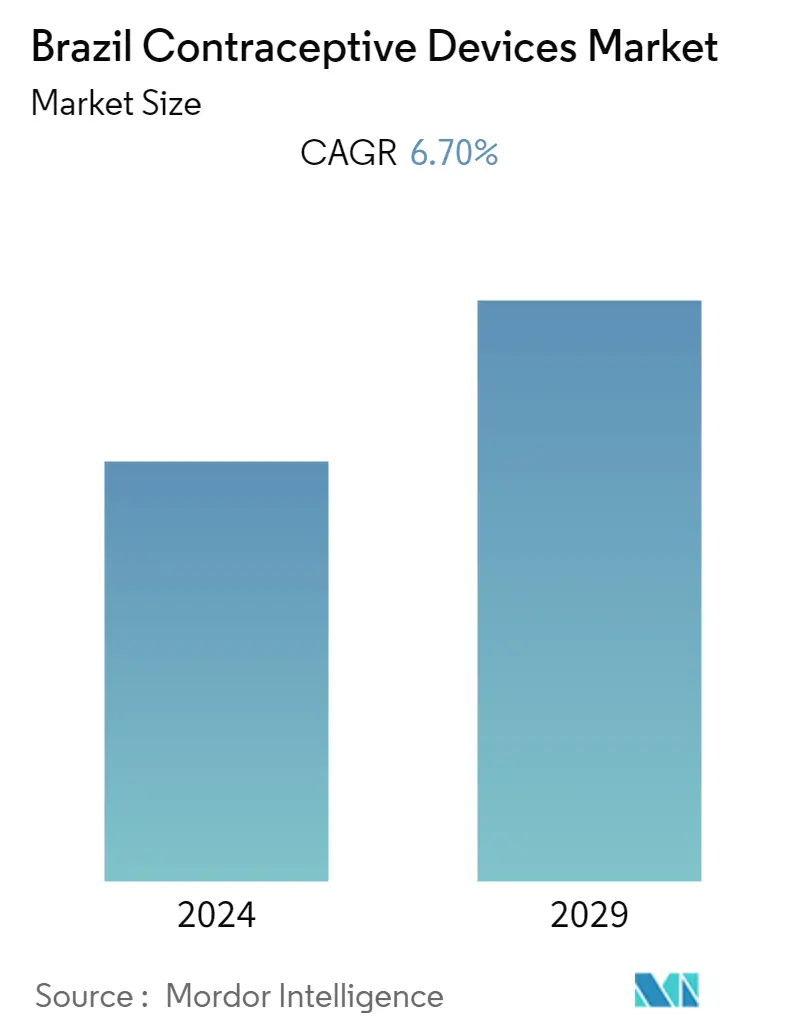Market Size of Brazil Contraceptive Devices Industry

| Study Period | 2019 - 2029 |
| Base Year For Estimation | 2023 |
| Forecast Data Period | 2024 - 2029 |
| Historical Data Period | 2019 - 2022 |
| CAGR | 6.70 % |
Major Players
*Disclaimer: Major Players sorted in no particular order |
Brazil Contraceptive Devices Market Analysis
The Brazil contraceptive devices market is expected to register a CAGR of 6.7% over the forecast period.
- COVID-19 was a global health emergency. The COVID-19 pandemic forced many companies in global contraceptive manufacturers to halt business operations for a short term to comply with new government regulations to curb the spread of the disease. This halt in operations directly impacted the revenue flow of the Brazilian contraceptive device market. For instance, in an article published in The European Journal of Contraception & Reproductive Health Care in February 2022, during the early phase, there was a decline in the use of contraceptives due to the temporary closure of clinics, and the sales of contraceptives fell during 2020. However, according to the same source, during the late pandemic, the increase in sales of the levonorgestrel-releasing intrauterine system (LNG-IUS) and etonogestrel (ENG) implant in the private sector indicated inequitable access to modern contractive methods, thereby driven the market growth. Therefore, Brazil's contraceptive devices market is anticipated to witness slow growth during the initial phase of the pandemic; however, post-pandemic, the market attained its pace and witnessed significant growth and is expected to do the same over the forecast period.
- The factors that are driving the Brazilian contraceptive devices market are the increasing incidence of sexually transmitted diseases (STDs) and a rise in unplanned pregnancies.
- Sexually transmitted infections (STIs), including Human immunovirus (HIV), syphilis, chlamydia, gonorrhea, trichomoniasis, and genital herpes, are major public health problems in Brazil. For instance, according to Brazilian Health Data, the number of outpatients in public hospitals in Brazil with unspecified HIV was 68,941in May 2023. Furthermore, according to an article published in the Journal of the Brazilian Society of Tropical Medicine in May 2021 reported the high prevalence of sexually transmitted diseases in Brazil, and there is a need for expanding access to diagnostic tests, and early treatment is crucial for controlling the spread of pathogens that cause cervicitis.
- An unintended pregnancy occurs from not using contraception or by inconsistent and incorrect use of contraceptive methods. The growth of the contraceptive market is a necessity to avoid unwanted pregnancies and their complications, especially among teenagers. For instance, in an article published in Frontiers in Public Health in April 2021, approximately 12 million adolescents aged 15-19 years, 770 thousand of whom are under 15 years, give birth each year in the developing world. Thus, high adolescent and unplanned pregnancies are anticipated to drive the market for contraceptive devices in the country. Also, governments and policymakers in the country are addressing sexually transmitted infections (STIs) among young people through high-quality sex education programs, access to clinical care, preventive technologies and vaccines, and confidential services. All these initiatives are making young people aware of sexually transmitted diseases (STDs) and thus increasing the need for contraceptive devices, thereby driving the market.
- Therefore, due to factors such as the huge prevalence of sexually transmitted diseases and rising unplanned pregnancies, the Brazil contraceptive devices market is expected to show significant growth over the forecast period. However, side effects associated with using contraceptive devices may slow down the market growth over the studied period.
Brazil Contraceptive Devices Industry Segmentation
As per the scope of the report, contraceptive devices are barriers that attempt to prevent pregnancy by physically preventing sperm from entering the uterus. Contraception is more commonly known as fertility and birth control, which is described as the method to avoid pregnancy. There are different types of temporary and permanent contraceptive devices, such as condoms and intra-uterine devices, that also help prevent sexually transmitted diseases (STDs).
The Brazil contraceptive devices market is segmented by type (condoms, diaphragms, cervical caps, sponges, vaginal rings, intrauterine devices (IUD), and other devices) and gender (male and female)
The report offers the value (in USD) for the above segments.
| By Type | |
| Condoms | |
| Diaphragms | |
| Cervical Caps | |
| Sponges | |
| Vaginal Rings | |
| Intra Uterine Device (IUD) | |
| Other Devices |
| By Gender | |
| Male | |
| Female |
Brazil Contraceptive Devices Market Size Summary
The Brazil contraceptive devices market is poised for significant growth, driven by increasing awareness and demand for contraceptive methods to address the high prevalence of sexually transmitted diseases (STDs) and unplanned pregnancies. The market experienced a temporary setback during the COVID-19 pandemic due to operational halts and reduced access to contraceptive services. However, post-pandemic, the market rebounded, with a notable rise in the adoption of modern contraceptive methods such as the levonorgestrel-releasing intrauterine system and etonogestrel implants. The growing incidence of STDs, including HIV and other infections, alongside the need to prevent unintended pregnancies, particularly among adolescents, is fueling the demand for contraceptive devices. Government initiatives aimed at enhancing sex education and providing access to preventive healthcare are further supporting market expansion.
Condoms are expected to dominate the market, supported by their affordability, ease of use, and effectiveness in reducing the risk of STDs and unintended pregnancies. The young population in Brazil, coupled with increased awareness through government campaigns, is driving the adoption of condoms. The male segment is also anticipated to grow, with rising awareness and initiatives promoting male contraception. The market is moderately competitive, with several international players actively participating and introducing innovative products. Recent approvals and investments by the Brazilian government in contraceptive services underscore the commitment to reducing unplanned pregnancies and STDs, further bolstering market growth.
Brazil Contraceptive Devices Market Size - Table of Contents
-
1. MARKET DYNAMICS
-
1.1 Market Overview
-
1.2 Market Drivers
-
1.2.1 Increasing Incidence of Sexually Transmitted Diseases (STDs)
-
1.2.2 Increase in Unplanned Pregnancies
-
-
1.3 Market Restraints
-
1.3.1 Side Effects Associated with the Use of Contraceptive Devices
-
-
1.4 Porter's Five Forces Analysis
-
1.4.1 Threat of New Entrants
-
1.4.2 Bargaining Power of Buyers/Consumers
-
1.4.3 Bargaining Power of Suppliers
-
1.4.4 Threat of Substitute Products
-
1.4.5 Intensity of Competitive Rivalry
-
-
-
2. MARKET SEGMENTATION (Market Size by Value - USD)
-
2.1 By Type
-
2.1.1 Condoms
-
2.1.2 Diaphragms
-
2.1.3 Cervical Caps
-
2.1.4 Sponges
-
2.1.5 Vaginal Rings
-
2.1.6 Intra Uterine Device (IUD)
-
2.1.7 Other Devices
-
-
2.2 By Gender
-
2.2.1 Male
-
2.2.2 Female
-
-
Brazil Contraceptive Devices Market Size FAQs
What is the current Brazil Contraceptive Devices Market size?
The Brazil Contraceptive Devices Market is projected to register a CAGR of 6.70% during the forecast period (2024-2029)
Who are the key players in Brazil Contraceptive Devices Market?
Bayer AG, Johnson and Johnson, Abbvie, Church & Dwight Co, Inc. and Reckitt Benckiser Group plc are the major companies operating in the Brazil Contraceptive Devices Market.

